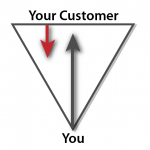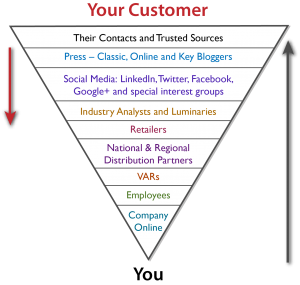Differences Between High Technology and Classic Consumer Marketing
 It all boils down to two key differences between classic consumer marketing and high-technology marketing discussed in my earlier blog post which talked about the fact that consumer goods do not change often while high technology products must change or risk obsolescence.
It all boils down to two key differences between classic consumer marketing and high-technology marketing discussed in my earlier blog post which talked about the fact that consumer goods do not change often while high technology products must change or risk obsolescence.
In addition, the path to “trial” for a consumer product is much easier in classic consumer goods where price points are much lower like soda or a detergent, or the offering is easy to try like cologne and perfume. Often high technology products are more expensive, more complex, hard to easily demonstrate the benefit(s) and trial is a much longer and difficult process.
Because of these differences, classic consumer marketing focuses directly on the target consumer and primarily uses some form of advertising to incent them to try through an initial purchase, which typically is less than $10. There is a temptation on the part of high technology marketing teams to go the same route if budgets permit.
In most companies, the budget does not allow for multimillion-dollar advertising expenditures and we’ll explain why they could be wasted funds and resources even if they did.
Trial
Most businesses and consumers want to be able to try before they buy (or commit) to a new product. The more expensive, complex, infrastructure-deep and mission-critical the product is, the tougher it is to get a trial with your target customer.
As an extreme example, I led the marketing efforts in a B2B broadcast network video over IP company where it took three years of engineering laboratory evaluation, standards body participation and some “golden eyes” from the broadcast network looking at the pre-game live feeds from satellite, classic terrestrial leased lines and IP video to go live with the first ever live HD broadcast video contribution feed for a major sports event using a packet-based network … Super Bowl XVIII … Janet Jackson and all. No one wants to lose their job over a “do-over” when the media buy is over $1 million for a 30-second commercial, so it was a long and complex process to reduce the risk in the minds of the broadcast network engineers.
As touched on above, most consumer goods are easy and inexpensive to try or buy, so advertising can be effective in reaching the consumer and where individual decision on small amounts triggers a purchase. As the amount grows larger, family members or business peers/associates become involved in the purchase decision.
Risk
A second difference is the degree of risk involved in technology purchases, either due to their complexity or anticipated obsolescence. Classic consumer products do not change very often, if at all, over time. Ivory soap has remained almost the same since it was introduced in 1879. On the other hand, high technology hardware and software products must change or risk rapidly losing market share.
The Key Component … Risk Reduction
In the video over IP example above, no one wanted to lose their job with a “do-over” when the media buy is over $1 million for a 30-second commercial, so it was a long and complex process to reduce the risk in the minds of the broadcast network engineers.
Today, almost everyone knows that as soon as you make a technology purchase, there will be another product that comes available that will do the same thing faster, better or cheaper, often from the same company. Additionally, once the funds are committed to the purchase, changing later can require a new purchase (i.e. new laptop) and/or significant internal effort to make the switch (i.e. eCommerce software).
As a result, your potential customers seek to reduce their perceived risk through referencing … asking others they know and trust about your product. Those trusted sources may rely on their own experience and what they read about your product. Potential customers also use the Internet to gather more information. We will talk more about this later.
Core to reducing risk is using the triangle to work the layers between you and your target customer to reduce the risk of purchase. Your communications proceed up the triangle, while customer referencing works in the opposite direction. The clearer your message and the better your proof, the more likely it is to have a positive impact.
Identifying the Layers
It is important to develop an understanding of all the layers between your company and your end customer, beginning with company employees.
As an example, let’s look at what a consumer software vendor’s triangle might look like the one to the left below.

Your communications and attempts to influence purchases begins at the bottom and moves up the triangle, while the referencing a potential customer undertakes begins at the top. The clearer your message and the more you have “socialized” it with each layer the more like laser light it will be than incandescent light. The implication? Each marketing dollar spent delivers more bang for the buck.
Online Information and Social Media … Today’s Complexity
The popularity of social media, blogging and comments has made the process much more complex in many people’s opinion, but I beg to differ. Electronic versions of magazines, social media and blogging, although different, can be treated like any other form of media. There are important parts, unimportant parts and unfortunately, the unwashed masses. Pay attention to the first and do your best to ignore the latter two.
In the not-distant-past consumers and businesses relied on the informed opinion of experts and friends they trusted and knew to help guide them through technology purchases. The Internet has corrupted that process. How do you know that “Dancing Bear 341” or “DB, San Diego” knows anything about the product s/he is dissing or promoting? For that matter, they may never have bought or used it. In far too many cases, they are paid “shills” who try to spread negative opinion about competitor’s products. If you do some homework, you will find that unfortunately the bulk of “Comments” on the Internet are negative. It must be some hidden part of human nature and anonymity that make people take out all their aggressions on the net.
It may take a while, but consumers will start to sort through the information online more carefully as they begin to understand what is going on. Businesses already get it to some degree, but don’t take this for granted.
Consumer and business sites are beginning to understand this and are making commenters use their “real names” or Facebook accounts to identify themselves rather than letting them leave a poisonous or glowing comment on their site that cannot be tracked.
What Can You Do?
Identify and engage key online influencers, analysts, reporters and bloggers as you would in any other media and find those sites where you believe the comments have the most weight in the minds of your target audience. (It’s not a bad idea to survey your target market to check you bets). The same is true for commenters on sites you identify as influential. Pay attention to those sites and respond in an informative, not combative manner, identifying yourself as an employee or representative of the company … open, transparent, helpful and calm.
It is very important that senior management understand you can simply not devote resources to handle everything on the Internet. Pick and choose where you put your resources carefully and let the rest go. I know it’s hard when executives and team members come in with posts from a site that are critical, but you have to pick and choose or you will be jumping around and not staying “on strategy”.
The Action Plan
- Pick a specific product, product family or service for the analysis.
- Identify as many layers as you can between you and your target customer.
- Build your own triangle.
- Create a list of the key people, companies, organizations, publishers, analysts, bloggers and influencers in each layer.
- Socialize the results with the rest of the marketing team.
- Vet it with the sales team.
- Develop marketing plan(s) to reach as many of the influencers within each of your layers.
- Get necessary budgetary approval, adjusting expectations and scope as necessary to fit the budget.
- Resist the temptation to try to reach everyone within a layer if the approved budget does not permit you to do so. Pare the list down and pay enough attention to those remaining. You have to ignore the rest until, and if, you get additional funds.
- Work the layers inside to outside to deliver the best results you can given the resources you can devote.
Tell me what you think …


